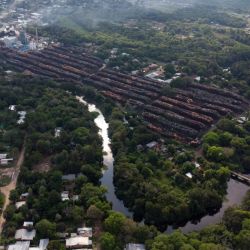Dwarfed by the Amazon, its more prestigious sibling, South America's second-largest forest is a little-known victim of 25 years of gradual invasion by agriculture and livestock farming.
The Gran Chaco indigenous forest that spans one million square kilometres (386,000 square miles) across Argentina, Paraguay and Bolivia is at the mercy of ravenous soybean and sunflower crops, as well as pasture land.
Comprising a mix of dry thorn shrubland, woodlands and palm savannas, the dense tropical dry forest contains massive scars – vast areas of deforestation gouged out with alarming regularity.
The harm to local fauna and flora is immeasurable.
In some places, as far as the eye can see, carob trees uprooted by heavy machinery lie waiting to be taken away and used as charcoal, tannin, furniture and railway sleepers, for which this dense hardwood is particularly prized.
Here, in Argentina's northeast, some 1,100-kilometres (685 miles) from Buenos Aires, is the country's agriculture frontier.
It is where the agro export industry, so crucial for a country short on foreign currency, advances at the expense of various species of fauna and flora, as well as people.
"Practically all of Chaco Province used to be covered by forests," agricultural engineer Inés Aguirre from the Chaco Argentina Agroforestry Network, who worked for decades in the provincial Forestry Directorate, told AFP.
"But when the technological package of genetically modified soybean appeared in the 1990s, the Chaco zone began to be colonised."
'Strong agro pressure'
Two of Argentina's main exports, soybean (30 percent) and genetically-modified corn are, like sunflowers, resistant to dry climates, allowing them to thrive in the semi-arid Chaco region.
Deforestation in the region has averaged around 40,000 hectares (154 square miles) a year, peaking at 60,000 on occasions, said Aguirre.
"This shouldn't happen because all forms of deforestation have been suspended in the province," said Noemi Cruz, the forests campaign co-ordinator at Greenpeace, while picking up a handful of dusty earth from a patch of ground cleared of trees.
Without the protection of those trees "water slides on the surface but won't penetrate the ground during the rainy season."
Chaco Province includes the El Impenetrable National Park, a 128,000-hectare region that is designated a "red zone" and strictly protected by a forestry law. But there are also "yellow" zones where tourism and "soft" agriculture are allowed, and "green" zones that are a free-for-all.
But this law has not proved sufficient to protect the forests.
"There is strong pressure from companies and agricultural producers that want to open up more farmland and there is a permanent international demand for primary materials, especially soybean and beef," said biologist and researcher Matías Mastrangelo, from the CONICET national scientific and technical research institute.
Together with the timber and real-estate sectors, "they are constantly pressuring the government to make the design of land use planning more flexible," he says.
In the case of illegal logging, a lightly punitive fine "does not discourage clearing and the companies incorporate it as another production cost."
What this means is that deforestation around El Impenetrable affects the rich fauna living within it, such as anteaters, peccaries, coral snakes, tapir and the continent's largest feline, the jaguar, which is endangered in the region and the subject of an ambitious reintroduction programme.
"A forest that becomes a soybean field can no longer provide shelter for the jaguar, nor any of its prey. The destruction is absolute," said biologist Gerardo Cerón, coordinator of the Rewilding Argentina team managing the predator's reintroduction.
Large mammals at risk
"In the dry Chaco, we are probably facing a very serious effect of losing fauna. We are seeing especially the extinction of large mammals," said Micaela Camino, a biologist at CONICET, citing the giant armadillo (tatú carreta) and white-lipped peccary (Tayassu pecari) as examples.
"When a species is lost, you lose what is unique about the species. But also the nutritional security of local families and all the functions that this species performed in the ecosystem,” she adds. "You're losing the ability of this ecosystem to survive, regenerate and be resilient, which is very dangerous in a context of climate change."
It is not just fauna and flora being pushed out but also local indigenous communities, such as the Wichi and Criollo who live in the forest.
"What generally happens is that before the logging, the rights of these families are violated. They are swindled (out of their land) and forced to leave their homes," added Camino, who won this year's Whitley Fund for Nature award.
Audencio Zamora Leckott, a leader of the local Wichí ethnic group, maintains that "the places where vegetation and the environment are preserved are where we, the indigenous peoples, live. Deforestation is the destruction of our cultures, knowledge and wisdom.”
Is it possible to reverse the deforestation process? Aguirre says there are solutions to regenerate the lost Chaco forest, starting with the replanting of the carob tree.
“The carob tree, which is a legume, produces a reaction between bacteria and the tree's roots that recomposes the nitrogen in the soil. It's amazing, the growth is incredible," she said.
But such programmes are for later, she adds. For now, the priority is "stopping deforestation."
Mastrangelo, in turn, calls on soy and meat-importing countries to exclude producers who work on deforested land from the market. "This is the most effective way to stop deforestation," he says.a
related news
by Nina Negron, AFP

























Comments